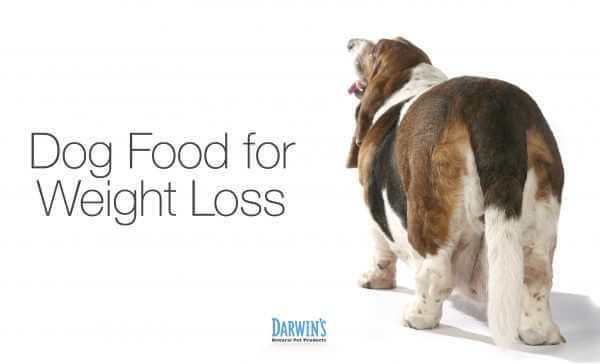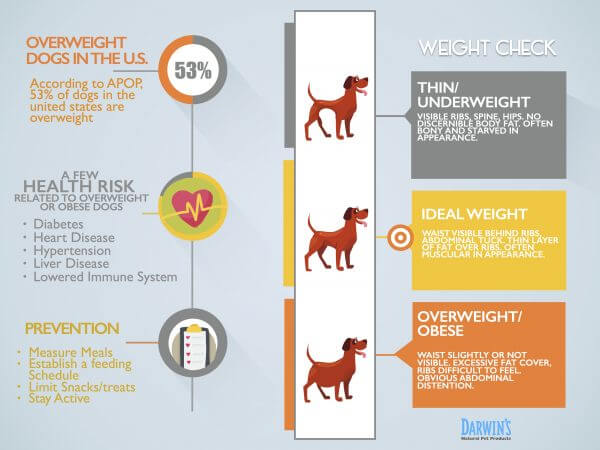Weight Loss and Dog Food
9/6/15

Last Updated on
Inside This Article
- How Do You Know If Your Dog Needs to Lose Weight?
- How Do I Get My Dog to Lose Weight?
- How Much Should You Feed a Dog for Weight Loss?
- What is the Best Weight Loss Food Recommended by Vets
All About Dog Weight Loss
You may not realize it, but the challenges people tend to face with their weight are the same challenges dogs encounter. Indeed, 53 percent of dogs in the U.S. are estimated to be overweight, according to the Association for Pet Obesity Prevention. But just as you can make healthy choices about your diet and lifestyle, you can also choose the healthiest routines and the best weight loss regime for your best friend. In this article, we’ll show you how to know if your dog needs to lose weight, if your dog’s breed tends to be overweight, what the best weight management dog food is, and how you can create great routines to reduce and maintain your dog’s weight.
How Does Your Dog Suddenly Need to Lose Weight?
Did you ever pull on your jeans one morning to suddenly find them too snug? How did that happen? Pounds can creep up on your dog, too. Just as it occurs with human, the weight adds up slowly until your dog is chubby or even obese.
Where does the weight come from? Much of the problem stems from dog parents failing to understand good dog nutrition or feeding dogs a diet that isn’t species appropriate. Unfortunately, dogs are easy to overfeed. We offer an abundance of treats, whether because we love them and want to them to have a coffee break or snacks with us, or because we’re training them and use nibbles as reward and incentive.
As people age, we tend to think we can continue to eat as much as we did as active 20-somethings, and so we likewise continue to feed our senior dog like she’s still a bouncy pup. And along with age, humans and dogs alike gain weight because we don’t get enough exercise, plain and simple. It’s also easy for owners overfeed if they don’t understand the breed. For example, if you’ve lived for years with a standard poodle and then adopt a Westie, you may need to adapt your dog meal planning.
How Do You Know If Your Dog Needs to Lose Weight?
Perhaps your dog is at a healthy weight. Or maybe he needs to go on a diet. How can you tell? Here’s how to get the skinny on your pet’s current situation:
- Ask your vet. Even if your vet doesn’t mention weight at your appointment, you can ask if your dog’s weight is appropriate.
- Watch that weight. Learn your dog’s ideal weight and monitor it weekly or monthly. For a smaller dog, buy a pet or baby scale (they’re quite inexpensive), or stop in at your vet’s regularly to use their scale. You can even use your own bathroom scale: First, weigh yourself. Next, weigh yourself while you hold your dog. Subtract one weight from the other and you have your dog’s weight. Note that zero to 15 percent more than the ideal is considered overweight, and more than 15 percent is considered obese.
- Perform the rib test. Look at your dog. You shouldn’t see rib bones; because that probably indicates that your dog is too thin. But if you feel near his spine and can’t easily detect his ribs, he may be too fat. Vets assign a score out of 9, with 5 being pretty much perfect. Darwin’s shows you what to look for in your pet’s silhouette and why it’s so important.

Why Is Fat a Problem for Dogs?
When it comes to weight, dogs aren’t all that different from people: Excess weight can cause dogs discomfort, and obesity can bring on serious health problems. Here are some of them:
- Trouble breathing
- Lung problems
- Sore joints and orthopedic issues
- Torn cruciate ligaments (similar to the ACL in humans)
- Hip dysplasia
- Arthritis
- Immune system problems
- Skin problems
- Heart problems
- High blood pressure
- Greater risk of heat stroke
- Pancreatitis
- Diabetes
- Mammary tumors (particularly in females who have not been spayed)
- Reduced lifespan
Doesn’t that list make you want to put your faithful friend on a diet?
What Dog Breeds Need to Lose Weight?
While weight problems aren’t a given, some breeds tend to pack on weight more easily than others. And breed size alone doesn’t matter. Dogs of the same size may need less or more food based on the activity level of their breed or personality. Here are a few examples of breeds prone to weight issues:
Small: Cairn Terriers, Dachshunds, Scottish Terriers, Cavalier King Charles Spaniels
Medium: Beagles, Cocker Spaniels, Basset Hounds
Large: Labrador retrievers, Golden Retrievers, Rottweilers
Giant: Bernese Mountain Dogs, Newfoundlands, St. Bernards
How Do I Get My Dog to Lose Weight?
You know why it’s not good for your dog to carry extra weight, and you know which dogs are likely to gain weight. But what if you’ve weighed your dog and found him wanting? What can you do?
Fewer Calories In, More Calories Out
For your dog, the simplest way to weight loss is through consuming fewer calories than are burned. You have a few ways to manage calories:
- Use portion control. The best way may be the easiest. Vets consider portion control better than worrying about reducing calories. Feeding your dog the right amount of satisfying food containing healthy fats (yes, they need good fat, just as you do!) will help your dog feel satisfied with potentially less food as well as reduce begging.
- Don’t overindulge. Consider treats a portion of the daily food allowance. Or offer treats that are vegetables and fruits, like blueberries and green beans. One woman’s standard poodles learned to love carrots after they saw her horse enjoying them.
- Stay firm when dogs beg. They may shadow you in the kitchen. They may whine and cry. But you have to resist the temptation to indulge them.
- Don’t free feed. The ducks don’t line up on the shore of the pond for the coyote at dinner time, and the wolf doesn’t munch caribou cutlets like mints in a candy dish. Dogs don’t eat whenever they want in the wild, and neither should dogs in the home.
- Calculate daily calories. It’s important to properly crunch the numbers if you want to reduce or maintain.

Change Your Routine
Beyond monitoring food for weight loss, change your routine:
- Get 10 to 15 minutes exercise several times a day. It’s good for both you and your dog.
- Feed your dog 2 to 4 times a day. Smaller amounts more often may help with begging
- Consider your dog’s age and activity level. An old dog or one recovering from surgery probably doesn’t need as much food as a young pup.
The Path to Weight Loss for Dogs
Now that you have a weight loss plan for your dog, monitor her weight every two weeks, remembering to use the same scale each time. Weight loss should be gradual, with dogs shedding only 1 to 2 percent of the ideal body weight per week.
If your dog isn’t losing weight, talk to your vet. Thyroid or other issues may be present. Dog diet pills should be the last option.
How Much Should You Feed a Dog for Weight Loss?
When people are serious about losing weight, they need to get serious about monitoring what they eat and look at how many calories they take in. The same is true for a dog. Here’s how you can accomplish this goal:
- Don’t eyeball food. Start measuring to ensure correct portions.
- Calculate protein needs. Dogs need 1 gram of protein per pound. Protein needs are constant, no matter how active your pet is.
- Cut back. Reduce intake by 15 to 20 percent over 6 to 8 weeks — in other words, about ⅛ cup for every 2 cups of food, which is about 5 percent of total daily required calories.
What Does a Dog Eat?
Just as you do, your dog needs high-quality proteins and the right amount of the right type of fat. Dogs even need some fruit and vegetables, although not as much as you should have on your plate. Here are a few things you need to know about protein:
- Animals manufacture amino acids from protein.
- Young animals need more protein for growth.
- Senior animals need more protein because they cannot manufacture the needed elements as well as younger animals.
Beyond the basics, dogs need vitamins and trace minerals, like L-carnitine for strong, healthy muscles and antioxidants and omega acids to keep them young.
What’s in Commercial Dog Food?
When it comes to dog food, you have so many kinds of food to choose from: kibble, canned, raw, and even freeze-dried or dehydrated. Aim to offer food with above-average protein (29 percent dry, 40 percent canned), below-average fat (16 percent dry, 23 percent canned), and below-average calories.
Protein burns more calories and supports strong muscles, and protein and the right fats give a feeling of satisfaction. Canned food usually contains more protein than kibble. Consider calories, too. If you feed kibble, choose a type with no more than 400 calories per cup.
When choosing dog food, read labels thoroughly, and steer clear of fillers, sugar, corn, soy, dyes, artificial flavors, and preservatives like BHA, BHT, and ethoxyquin. Though commercial prescription diets may seem like the right answer, be careful of foods that offer too many calories but not enough nourishment.
Many experts agree that raw dog food is an excellent option for weight maintenance and weight loss. It’s natural, biologically appropriate, and free of harmful ingredients. Head to the Darwin Pet Products blog to learn more about the benefits of a raw diet and why raw dog food is naturally premium.
What is the Best Weight Loss Dog Food Recommended by Vets?
No one ideal diet. Depends on dog’s age and health status, pregnant, nursing
Ingredients
- If the first ingredient listed is corn, consider it with scorn
- No grain or very limited grain
- Corn free and grain free may substitute rice or potato
- First ingredients should be meat or poultry
- However, all meat, no veg isn’t good either
- Fruit and veg may be trace elements so add your own
- Meat used to be considered bad, that excess protein and phosphorus would harm kidneys
- Chicken may be best, your mileage may vary
- Some saw raw works because it eliminates allergens, not just because it is raw
How to find good food for dog weight loss
- Read the Guaranteed Analysis on labels
- Look at AAFCO statement
- At least 30 percent protein
- At least 18 percent fat
- Preservatives in omegas and vitamin e
- micronutrients
- Be careful with vitamins (supplementation) esp. Calcium in pregnant dogs
- Good quality commercial food may be easier than preparing organic at home
Common allergens
- Chicken, lamb, beef, wheat, corn, soy, egg, dairy
- Food with fish oil and w/o these can help skin issues
Give Darwin’s a Try
- 75% protein, 25% veg
- No grains, no fillers
- Raw, so micronutrients not reduced by heat
- Omegas 3 &6
- Under 400 calories per cup



